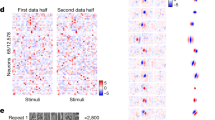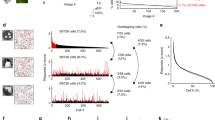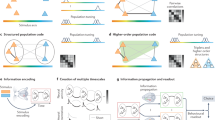Abstract
Correlated firing among neurons is widespread in the visual system. Neighbouring neurons, in areas from retina to cortex, tend to fire together more often than would be expected by chance. The importance of this correlated firing for encoding visual information is unclear and controversial1,2,3,4,5. Here we examine its importance in the retina. We present the retina with natural stimuli and record the responses of its output cells, the ganglion cells. We then use information theoretic techniques to measure the amount of information about the stimuli that can be obtained from the cells under two conditions: when their correlated firing is taken into account, and when their correlated firing is ignored. We find that more than 90% of the information about the stimuli can be obtained from the cells when their correlated firing is ignored. This indicates that ganglion cells act largely independently to encode information, which greatly simplifies the problem of decoding their activity.
This is a preview of subscription content, access via your institution
Access options
Subscribe to this journal
Receive 51 print issues and online access
$199.00 per year
only $3.90 per issue
Buy this article
- Purchase on Springer Link
- Instant access to full article PDF
Prices may be subject to local taxes which are calculated during checkout




Similar content being viewed by others
References
Gray, C. M. The temporal correlation hypothesis of visual feature integration: still alive and well. Neuron 24, 31–47 (1999).
Shadlen, M. N. & Movshon, J. A. Synchrony unbound: a critical evaluation of the temporal binding hypothesis. Neuron 24, 67–77 (1999).
Panzeri, S., Schultz, S. R., Treves, A. & Rolls, E. T. Correlations and the encoding of information in the nervous system. Proc. R. Soc. Lond. B 266, 1001–1012 (1999).
Nirenberg, S. & Latham, P. E. Population coding in the retina. Curr. Opin. Neurobiol. 8, 488–493 (1998).
Meister, M. Multineuronal codes in retinal signaling. Proc. Natl Acad. Sci. USA 93, 609–614 (1996).
Meister, M., Lagnado, L. & Baylor, D. A. Concerted signaling by retinal ganglion cells. Science 270, 1207–1210 (1995).
Warland, D. K., Reinagel, P. & Meister, M. Decoding visual information from a population of retinal ganglion cells. J. Neurophysiol. 78, 2336–2350 (1997).
Rodieck, R. W. Maintained activity of cat retinal ganglion cells. J. Neurophysiol. 30, 1043–1071 (1967).
Mastronarde, D. N. Correlated firing of cat retinal ganglion cells. I. Spontaneously active inputs to X- and Y-cells. J. Neurophysiol. 49, 303–324 (1983).
Mastronarde, D. N. Correlated firing of cat retinal ganglion cells. II. Responses of X- and Y-cells to single quantal events. J. Neurophysiol. 49, 325–349 (1983).
Devries, S. H. Correlated firing in rabbit retinal ganglion cells. J. Neurophysiol. 81, 908–920 (1999).
Chichilnisky, E. J. & Baylor, D. A. Synchronized firing by ganglion cells in monkey retina. Soc. Neurosci. Abstr. 25, 1042 (1999).
Alonso, J. M., Usrey, W. M. & Reid, R. C. Precisely correlated firing in cells of the lateral geniculate nucleus. Nature 383, 815–819 (1996).
Perkel, D. H., Gerstein, G. L. & Moore, G. P. Neuronal spike trains and stochastic point processes. II. Simultaneous spike trains. Biophys. J. 7, 419–440 (1967).
Shannon, C. E. & Weaver, W. The Mathematical Theory of Communication (Univ. Illinois Press, Urbana, Illinois, 1949).
Strong, S. P., Koberle, R., de Ruyter van Steveninck, R. R. & Bialek, W. Entropy and information in neural spike trains. Phys. Rev. Lett. 80, 197–200 (1998).
Cover, T. M. & Thomas, J. A. Elements of Information Theory (Wiley, New York, 1991).
Reinagel, P. & Reid, R. C. Temporal coding of visual information in the thalamus. J. Neurosci. 20, 5392–5400 (2000).
Ruderman, D. L. & Bialek, W. Statistics of natural images: Scaling in the woods. Phys. Rev. Lett. 73, 814–817 (1994).
Carter-Dawson, L. D. & LaVail, M. M. Rods and cones in the mouse retina. I. Structural analysis using lights and electron microscopy. J. Comp. Neurol. 188, 245–262 (1979).
Penn, J. S. & Williams, T. P. A new microspectrophotometric method for measuring absorbance of rat photoreceptors. Vision Res. 24, 1673–1676 (1984).
Soucy, E., Wang, Y., Nirenberg, S., Nathans, J. & Meister, M. A novel signaling pathway from rod photoreceptors to ganglion cells in mammalian retina. Neuron 21, 481–493 (1998).
Dodd, R. L. in Program in Neurosciences 153–156 (Stanford Univ., Palo Alto, 1988).
Nirenberg, S. & Meister, M. The light response of retinal ganglion cells is truncated by a displaced amacrine circuit. Neuron 18, 637–650 (1997).
Meister, M., Pine, J. & Baylor, D. A. Multi-neuronal signals from the retina: acquisition and analysis. J. Neurosci. Methods 51, 95–106 (1994).
Bialek, W., Rieke, F., de Ruyter van Steveninck, R. R. & Warland, D. Reading a neural code. Science 252, 1854–1857 (1991).
Acknowledgements
We thank J. Assad, A. Pouget, T. Otis, D. Buonomano and M. Goldman for critical reviews of the manuscript. We also thank M. Jack, J. Sinclair, F. Schweizer, J. Feldman and M. Meister for helpful discussion. This work was supported by grants from the Beckman Foundation and the Klingenstein Fund (S.N.).
Author information
Authors and Affiliations
Corresponding author
Supplementary information
Rights and permissions
About this article
Cite this article
Nirenberg, S., Carcieri, S., Jacobs, A. et al. Retinal ganglion cells act largely as independent encoders. Nature 411, 698–701 (2001). https://doi.org/10.1038/35079612
Received:
Accepted:
Published:
Issue Date:
DOI: https://doi.org/10.1038/35079612
Comments
By submitting a comment you agree to abide by our Terms and Community Guidelines. If you find something abusive or that does not comply with our terms or guidelines please flag it as inappropriate.



